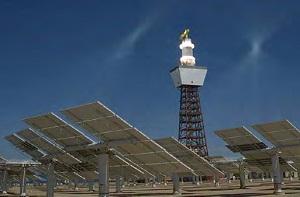SolarReserve among the final recipients of federal loan guarantees
 Late last week, SolarReserve LLC won a $737 million conditional commitment loan guarantee to support the development of its 110-megawatt Crescent Dunes Solar Energy Project in Nevada. The solar power tower project in Tonopah, Nev., is expected to break ground this summer and start producing power in late 2013.
Late last week, SolarReserve LLC won a $737 million conditional commitment loan guarantee to support the development of its 110-megawatt Crescent Dunes Solar Energy Project in Nevada. The solar power tower project in Tonopah, Nev., is expected to break ground this summer and start producing power in late 2013.
The loan guarantee is instrumental in helping SolarReserve find other financing for the project. “We’ve been working with a number of potential investors in addition to SolarReserve itself,” said the company’s chief financial officer Michael Whalen. “We’re in an advanced stage of discussion but haven’t made any announcements.”
Having the clarity through the loan guarantee is crucial to securing other investors in the project, according to Whalen.
The project is under a power-purchase agreement with NV Energy, Whalen said. When completed, it is expected to be the largest molten salt power tower project in the world and will provide electricity to approximately 75,000 homes during peak electricity periods.
“It has a very high-capacity and will put out about 500 gigawatt hours a year,” he said.
SolarReserve’s molten salt solar tower systems use a field of heliostats to concentrate sunlight on a centralized tower. The tower is filled with molten salt, which serves as a heat transfer mechanism (molten salt is excellent at storing thermal energy). The heated salt is used to superheat water into steam, and the resulting steam pushes an electric turbine.
This method offers benefits that other systems can’t.
“Our technology is certainly capable of storing energy; you collect it during the day,” Whalen said. The energy can power the turbine during the day, but it can also be banked for use at night. “Because we’re collecting during the day and able to store it, we’re able to produce in the evening as well.”
Other concentrated solar tower systems may have larger turbines, but they’re not capable of producing energy as fast.
“We may have a smaller steam turbine, but the number of hours we’re putting out is more,” Whalen said. The technology is ideal for Nevada because the state requires power that goes well into the evening, he said. But it’s unlike photovoltaics, where very small changes can affect the grid.
“The generation profile is very consistent and is based on what we have in storage,” he said.
In addition to the Nevada tower, SolarReserve is seeking a loan guarantee for another project, the Rice Solar Energy Project in California, Whalen said. That project will be a 150-megawatt project in Riverside.



